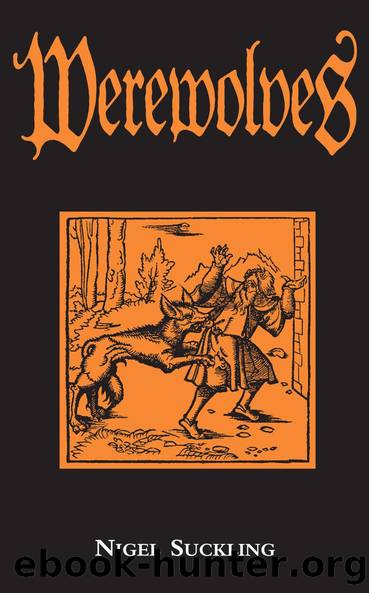Werewolves by Nigel Suckling

Author:Nigel Suckling [Suckling, Nigel]
Language: eng
Format: epub
Publisher: G2 Rights Ltd
Published: 0101-01-01T00:00:00+00:00
Chapter III : Shadows in the Night - Werewolves in Fiction
Many werewolf stories have been written over the centuries, shaping the popular view of these monsters, but they have not yet crystallised into any monumental classic equivalent to, say, Dracula in relation to vampires or Mary Shelleyâs Frankenstein in relation to, well, Frankenstein monsters.
*
A very popular early rhymed romance was Bisclavret by Marie de France, a twelfth century poet in England who was possibly a half sister to King Henry II. Bisclavret is the Breton word for werewolf and the story tells of a great lord in Brittany who troubles his loving wife by his habit of disappearing for three whole days each week without explanation.
Finally she teases the truth out of him and he confesses that for those three days he wanders in the depths of the forest as a werewolf, living by violence and blood. He has to be naked for this and eventually she coaxes from him the secret of where he hides his clothes, without which he is unable to change back into a man.
A while later the wife falls in love with someone else and persuades her lover to steal her lordâs clothes while he is away so he is doomed to remain a wolf. In due course he is declared dead and his wife marries her lover but, this being a fairytale, they do not live happily ever after. After many adventures the werewolf finally succeeds in making the truth known and, his clothes having luckily not been destroyed, is able to resume human form and exact vengeance.
*
An interesting point about Bisclavret is that there is no censure of the lord for being a werewolf, presumably because he only attacked animals. He is the righteous party in the fable.
*
Another case of a noble werewolf in twelfth century romantic poetry is The Romance of William of Palermo or William and the Werewolf whose popularity was continued as a prose version in the sixteenth century.
*
The tale is rather long and complicated but at the heart of it is that young William, Prince of Apulia, is snatched away as a child by a seemingly ravening wolf. It swims with him in its jaws from Sicily to Italy and then to a forest near Rome where, far from making a meal of him, the wolf nurtures William tenderly and raises him to a young man, later helping in the adventures that lead to him becoming Emperor of Rome. It turns out that the wolf is a prince under enchantment who had saved William from a plot to kill him. This Prince Alphonsus finally recovers human form to become King of Spain.
*
John Websterâs Jacobean play The Duchess of Malfi has a werewolf in the form of the heroineâs tormented twin brother, whose lycanthropy is suggested to have been brought on by melancholy; but this is not central to the story.
*
Other novels and plays also introduced lycanthropy as spice to their plot. In the nineteenth century tales like Hugues, the Wer-Wolf by Sutherland Menzies (1838), Wagner the Wehr-Wolf (1846) by George W.
Download
This site does not store any files on its server. We only index and link to content provided by other sites. Please contact the content providers to delete copyright contents if any and email us, we'll remove relevant links or contents immediately.
| Fairy Tales | Folklore |
| Mythology |
Circe by Madeline Miller(8021)
Confessions of an Ugly Stepsister by Gregory Maguire(7831)
A Court of Wings and Ruin by Sarah J. Maas(7653)
Burn for You (Slow Burn Book 1) by J.T. Geissinger(7033)
The Bird and the Sword by Amy Harmon(5193)
A Lesson in Thorns (Thornchapel Book 1) by Sierra Simone(5036)
Into the Drowning Deep by Mira Grant(4420)
Stolen (Alpha's Control Book 1) by Addison Cain(4143)
The Queen and the Cure (The Bird and the Sword Chronicles Book 2) by Amy Harmon(3976)
Mythology by Edith Hamilton(3717)
Pernicious Red (When The Wicked Play Book 1) by Natalie Bennett(3479)
Run Little Wolf (The Forest Pack Series Book 1) by G. Bailey(3459)
The Queen and the Cure by Amy Harmon(3191)
(Maiden Lane #5) Lord of Darkness by Elizabeth Hoyt(3018)
Lost Boy by Christina Henry(2974)
Mythos by Stephen Fry(2809)
The Fairy Queen (The Dark Queens Book 6) by Jovee Winters(2769)
Persephone by Kitty Thomas(2653)
Bunny by Mona Awad(2358)
